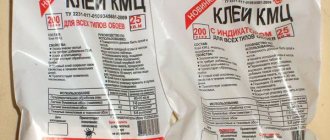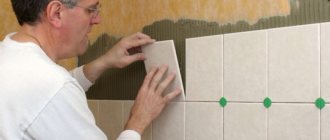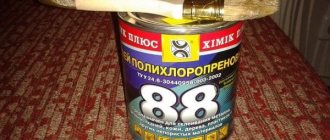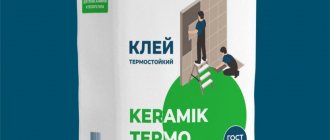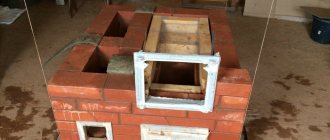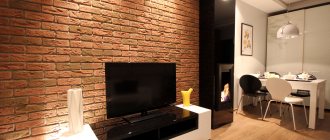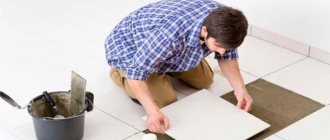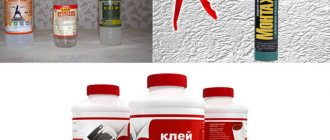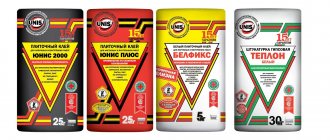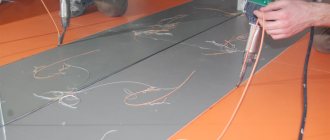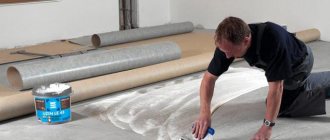Winnie the Pooh said that honey can be right or wrong. The same can be said about bathroom tile adhesive. If you make the wrong choice, then in a room with difficult operating conditions you can get, not immediately of course, but over time, peeling of the tiles. Repeated repairs due to incorrect adhesive entail many problems: dust, dirt, noise when removing the old finish, financial and labor costs when redoing previously completed finishing work. To prevent this from happening, the editors of the StroyGuru website decided to figure out which adhesive for bathroom tiles is better.
Characteristics of tile adhesive
Next, we will look at the characteristics of the best tile adhesive.
- The glue must be waterproof. Because there is always high humidity in the bathroom.
- Tile adhesive should dry quickly. Typically the glue dries within five hours. This is very important when work doesn’t wait. We need to finish the renovations and move as soon as possible.
- Must include additives against mold and fungi.
The best adhesives
- Ceresite. A very well-known brand that offers high-quality glue. It is important not to run into a fake, so when purchasing you need to ask for a quality certificate.
- Eunice. An excellent moisture-resistant adhesive that is resistant to temperature changes.
- Knauf.
- Typhoon.
- Litokol.
Each of these manufacturers offers good tile adhesives, which have their own advantages and features of use.
Types of tile adhesive for the bathroom
There are types of tile adhesives such as cement, anhydrous and paste.
Cement tile adhesive for bathroom
This glue contains sand, cement, and polymer components that impart certain properties. It is usually white or gray in color.
- Before you buy cement adhesive, you need to find out what type of tile it is and on what surface it will be laid.
- If the tiles are ordinary, then you can buy absolutely any cement-based adhesive.
- And for porcelain tiles you need a tile adhesive that has a high degree of wettability.
- This is necessary so that the glue adheres well to the tile.
To prepare the glue, you need to mix the dry mixture with water in the correct proportion. The glue can be placed both on the base and on the tile itself. For whom it is more convenient to work. It is more convenient to apply the glue to a special construction spatula in the shape of teeth. The thickness of the adhesive depends on the size of the tile. The larger the tile size, the more adhesive needs to be applied.
What should you consider when choosing?
Key points to pay attention to:
- The weight and some features of the material, as well as its size. For example, almost any option is suitable for fixing ceramics - it is lightweight and securely attached to the base, even with a mixture with a low adhesion rate. For large tiles, stone, marble, granite, you will have to choose an adhesive with increased strength.
- Features of the base, as well as the presence of cracks and irregularities on the surface. Wood and drywall require additional processing so that it sticks even with elastic glue.
- Features of the room, humidity and temperature variability.
Base
Which bathroom tile adhesive to choose depends on the base. The wall can be made of plasterboard, concrete, brick, less often - wood, sand-cement screed, metal, glass, plastic. Manufacturers usually write on the packaging which materials it adheres to best, and which ones it will hold the tiles on very weakly.
Particular attention should be paid to the possibility of deformation of the base and the impact of various types of vibrations on them.
For example, wood begins to swell due to high humidity if it is not subjected to special treatment. In this case, you will have to choose an adhesive that will take into account this feature of the wooden base and will securely hold it in place.
Ceramics
The material is quite light, so choosing glue is not much of a problem. The advantages of ceramics are affordable cost and high levels of moisture resistance and temperature resistance.
Porcelain tiles are considered an improved version of ceramic tiles.
Room
For the bathroom or kitchen, it is recommended to select mixtures that repel water and do not absorb it. To protect the tile surface after using the adhesive, you can apply a moisture-repellent coating on top, since fumes penetrate through the seams and can cause the adhesive to disintegrate.
Paste tile adhesive
This tile adhesive is very popular abroad. This is glue in the form of a paste. It is much better than cement glue. It has a lot of advantages. White tile adhesive.
Apply it using a toothed spatula. The larger the tile, the thicker the adhesive should be.
Advantages of ready-made glue
- This glue is already prepared. There is no need to mix anything, get dirty, waste time on preparation, and so on.
- This glue is very useful where there is no water.
- It does not have to be applied in a thick layer. It will cope with its task if applied in a small layer to the surface. This glue is mainly used if the tiles are in the form of a mosaic.
Disadvantages of ready-made glue
- Does not withstand frost.
- Cannot be used for street masonry.
Marking features
There are letter designations on the glue packaging - this is its characteristic.
In accordance with the European standard, the following markings are accepted:
- C - cement glue.
- R - based on reactive resins.
- F - fast hardening. Reduces work completion time.
- T - thixotropic. Used for vertical surfaces.
- E - open time increased. Suitable for beginners, because when working with it there is time to adjust the tiles.
In a cement mixture, numbers 1 and 2 indicate the strength to withstand the load towards the base. For C1, adhesion is at least 0.5 MPa, for C2 - at least 1.0 MPa.
S1 and S2 characterize the elasticity of the glue after drying. S1 is capable of bending under load by no less than 2.5 mm, and S2 by 5.0 mm.
You can improve the C1 cement mixture by adding latex - this will increase the elasticity of the glue. Nothing should be added to a mixture where S1 or S2 is indicated in the composition, as the quality may deteriorate.
Waterless adhesive
This is a glue that does not require water during preparation. The glue begins to harden when the components are mixed. A huge advantage of such adhesives is that they are suitable for any tile.
To prepare this glue, you need to mix 2-3 components thoroughly. The mass should become homogeneous. You need to glue immediately after preparing the glue.
This glue is also called reactive glue. Divided into three types.
- Polyurethane. Its texture is elastic. This property does not change under any weather conditions. This type of glue can be applied to almost any surface. Only not recommended for bituminous substrates. It is mainly used for mosaics, marble and so on.
- Epoxy. It consists of two components. It is acid resistant. This glue is mainly used in hospitals, clinics, and industrial premises.
- Epoxy-polyurethane. It is very durable, as it contains both epoxy resins and various polyurethane compounds.
How to calculate consumption?
It is important to correctly calculate how much glue is needed for repairs. Usually the approximate glue consumption is indicated on the packaging, but you can make the calculations yourself.
How to calculate consumption:
- Determine the area of the surface to be coated. It is calculated by the formula: multiply the width of the room by its length. If the room is of a non-standard shape, you will have to mentally divide it into geometric shapes and add up the areas of each of them.
- Calculate the quantity required for repairs. Divide the area of the kitchen or bathroom by the area of one tile.
- The skill of the specialist must be taken into account. An inexperienced glue master will spend much more glue, since there is a risk of spoiling the composition or using it in excess.
- Much less glue is used on a flat surface - some of it will not accumulate in cracks and irregularities, trying to close them and provide better adhesion to the material.
The consumption will be higher for an inexperienced craftsman who does not know what layer thickness will be enough and may re-lay some slabs. Laying technology also affects the amount of glue.
The approximate consumption of adhesive for tiling is indicated in the table below.
| Size | Adhesive layer thickness | Approximate quantity (kg/m2) |
| 10x10 | 5 mm | 3 |
| 20x20 | 8 mm | 4 |
| 30x30 | 10 mm | 5 |
Main manufacturers of tile adhesive
Next, popular manufacturers of tile adhesive will be considered.
Ceresit tile adhesives
The Ceresit company produces several types of tile adhesives that can be used in the bathroom.
Ceresit CM11 tile adhesive is considered universal.
Ceresite CM11 PLUS is more elastic. It is also moisture resistant.
- The finished adhesive must be used within three hours.
- You can only adjust the tile within ten minutes.
- Ceresit CM12 is suitable for porcelain stoneware and large tiles.
Ceresit CM16 tile adhesive is purchased to lay tiles no larger than forty centimeters in size.
Yunis tile adhesives
This Russian nonsense is in second place in popularity. The range of tile adhesives is also varied. Unis Plus is suitable for bathrooms.
It is heat-resistant, thanks to this property it can even be placed on a warm floor. Unis 2000 tile adhesives are used for uneven walls and floors. This glue is suitable for both tiles and porcelain tiles.
Knauf tile adhesives
The Knauf company produces four types of tile adhesive.
- Knauf non-woven tile adhesive. This is a cement based adhesive. Used for laying both tiles and porcelain stoneware. It has high adhesion to any surface. This glue contains sand, cement and special additives.
- Knauf fleece plus. It is suitable for both internal and external work. This glue is resistant to both frost and moisture. Does not slip when applied.
- Tile adhesive Knauf Flex. This adhesive is suitable for applying adhesive to old tiles or wood. Has properties such as moisture resistance, elasticity
Tips for choosing tile adhesive
- For a concrete wall, tile adhesive that contains a cement base is suitable. It is inexpensive, convenient to place on the wall, but there are also disadvantages. It takes a lot of time and it doesn’t always work out the first time. You just need to practice a little and everything will work out. This glue is sold dry. Water is added there immediately before work.
- If adhesives are applied to drywall, it is better to buy dispersion adhesive. Sold in paste form.
- Epoxy glue is used if the base of the wall is wooden or iron. It is in the form of a paste-like consistency. It has good adhesion.
- If the tile is large, then it is necessary that the composition must contain components such as latex components and quartz sand granules.
- For mosaics you need to use only white glue.
- Before you buy glue, you need to look at the shelf life of the glue. Expired glue loses its properties.
The size of the tile determines what adhesive you need to purchase. The heavier and larger the tile, the stronger the adhesive you need to use.
Breeding technology
In the specified proportions, which are on the package, you need to stir the dry mixture in water.
- Pour the required volume of water into a clean bucket.
- The required amount of mixture is poured into a clean container.
- The water in the bucket begins to be mixed with a mixer or drill. Slowly, stirring constantly, pour the mixture into the funnel formed in the water.
- When the entire mixture is poured in, kneading continues until the solution becomes thick with a uniform consistency without lumps.
- Time is given, for example 5 minutes, for the solution to infuse.
- Mixing is done again, the mixture is ready for application.
